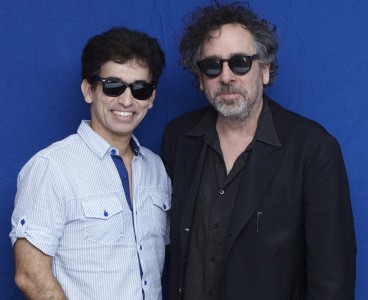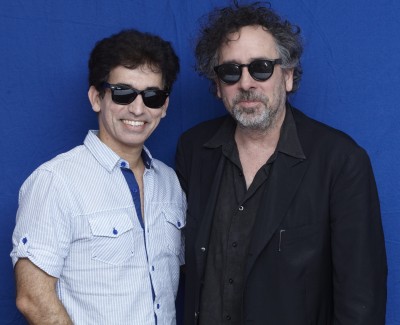
No one in Hollywood personifies his own movies as Tim Burton does. He arrives at our meeting in the Casa Del Mar hotel on Santa Monica beach dressed in loose black shirt and trousers, his hair unkempt, his face buried under a greying beard and, like a vampire, his eyes kept covered with dark shades, even though we’re sitting in a dimly-lit room. He looks as gothic as his art and as wild as his imagination.
Since his first movie Pee-wee’s Big Adventure in 1985, Burton has developed a reputation for a surreal artistic vision that invokes German expressionism. But he insists that the dark look and gothic style of his movies is largely inspired by watching early horror movies, which were designed and directed by German immigrants, who had expressionism in their background.
Burton’s beautifully designed and highly stylised films, including Batman, Edward Scissorhands, Beetlejuice, Big Fish, Sleepy Hollow and Ed Wood, in which he mixes gothic horror, black comedy and oddball whimsy, are an idiosyncratic, personal vision that have found commercial success and proved his doubters wrong. “I grew up with movies. I know they are known as business, but for me they have always been an artform,” he stresses.
With roots in drawing and animation, Burton began his film career at Disney as an apprentice animator in the early 80s. But his style was soon deemed to be too dark for the Mouse House’s taste. “Let’s say they were not crying when I left,” he explains, chuckling. “I’ve been in and out of there many times. It’s like revolving door policy, but I always am grateful because I got to do my first movies and that was amazing.”
Indeed, before he left Disney, Burton made his first animated short Vincent (1982), which tells the story of a boy living in a fantasy world of Gothic horror while imagining he is Vincent Price, and his first live action short Frankenweenie (1984), which tells the story of a boy, Victor, who resuscitates his beloved dead dog back to life with the power of electricity.
Those autobiographical characters were the prototypes for the misunderstood, sympathetic outsider at the center of most of Burton’s subsequent films, that were evidently drawn from the contrarian director’s upbringing in Burbank California, where he grew up as a lonely and isolated child.
“I remember you feel quite normal and at the same time other kids seem weird to you,” he reflects. “Everybody is treating you like you’re weird but everybody seems strange, so it’s just that weird dynamic.”
Disenchanted with his homogenised suburban surroundings and detached from its inhabitants, including his parents, Burton spent most his time daydreaming, watching horror movies and pouring through issues of Famous Monsters of Filmland. The young dreamer quickly developed a special bond with mythical creatures. “I like all monsters,” he exclaims, grinning. “I was equal opportunity monster.”
Burton’s love for and obsession with monsters has been evident in many of his movies, including his latest black-and-white animated feature adaptation of his 1984 short Frankenweenie, a semi- autobiographical film that sheds more light on the director’s early life, his relationship with his surroundings and the images of monsters that crowded his precocious mind.
“The film is based on a memory that I had when I was growing up and with my relationship with a dog that I had,” Burton says, sipping water from a bottle. “The great thing about expanding Frankenweenie is that thinking about other things that were personal, like the other kids that I remember and the teachers and the kind of place, so I put a lot of memories of things into the whole.”
Although the young Burton, who knew that his beloved dog was not going to live long due to a medical condition, did fantasise about applying Frankensteinian methods to endow it with a new life, he had never had to do it, because the dog ended up living a long life. “But there was always a spectre that it wasn’t going to last and I think that’s what linked it to the whole Frankenstein mythology for me. It was taking something personal and relating it to those kind of films, which meant a lot to me,” Burton enthuses.
And unlike the boy in the film, who is cherished and supported by his parents, Burton had a difficult relationship with his family, particularly his father, who, having been a professional baseball player, tried to coerce him into sport. “My parents weren’t quite as optimistically supportive as they are in the film,” he laughs. “It’s a bit more of a fantasy. That’s probably the only unreal element in the film.”
Having found solace in horror films, Burton regards them the same way a fairytale or a folktale relate to real-life issues, “I felt like Frankenstein and the neighbours were the angry villagers,” he quips. Hence despite the pervasive influence of his favourite classic horror films, in terms of style and look, in Frankenweenie, he insists that “It’s a boy and his dog story that just happens to be Frankenstein kind of thing.” This time Disney accepted his reasoning and greenlit the project.
To mirror the Frankenstein story and add another element of depth to Frankenweenie, Burton decided to film in stop-motion, which required him to draw all the sketches of the puppets by himself and then spend two years animating them in 3D with the help of a diverse, multi-talented crew. “It was just something about the power of creating something out of nothing, which is again why I like stop motion. It is taking basically a lifeless puppet and making it come to life,” says Burton.
Upon completing the movie, Burton brought in his two kids and their class to the set, where they played with the puppets and got to see the movie. “I feel quite good that they both like monster movies. I feel like I’m a good parent finally,” he laughs, contently.
Unlike monsters, his birthplace Burbank, which he remembered with “horror and fondness,” is not something that he dwells on or he would ever contemplate returning to. “I remember when I worked at Disney, I could see from my room the hospital where I was born and the cemetery where my family was all buried so it was like this Bermuda Triangle for me, and I would just sit out there and stare out the window all day and just go that’s where I was born, that’s where I’m going to be buried, and this where I am working. Oh gee,” he quips, shaking his head.
That was one the reasons behind his departure from his grim existence in Burbank. Currently, he lives in London, with his two kids and partner actress Helena Bonham Carter, where he feels more in touch with the world and the people around him. “Growing up the way I did, I find Los Angeles a hard city because you have to drive everywhere, which helped support the sense of isolation.”
Nonetheless, in spite of leaving Los Angeles, attaining glorious success and forming a family, the 54-year-old still retains the feelings of isolation that he grew up with and he doesn’t believe that they will ever leave him. “I’ve just became a successful, lonely, isolated adult,” he laughs.
Listing to Burton is akin to watching one of his movies. Passionate in his speech and animated in his delivery, he combines the innocence and enthusiasm of a child with the eccentricity and unpredictability of Frankenstein. Evidently, these qualities were behind the spring of Burton’s creativity.
